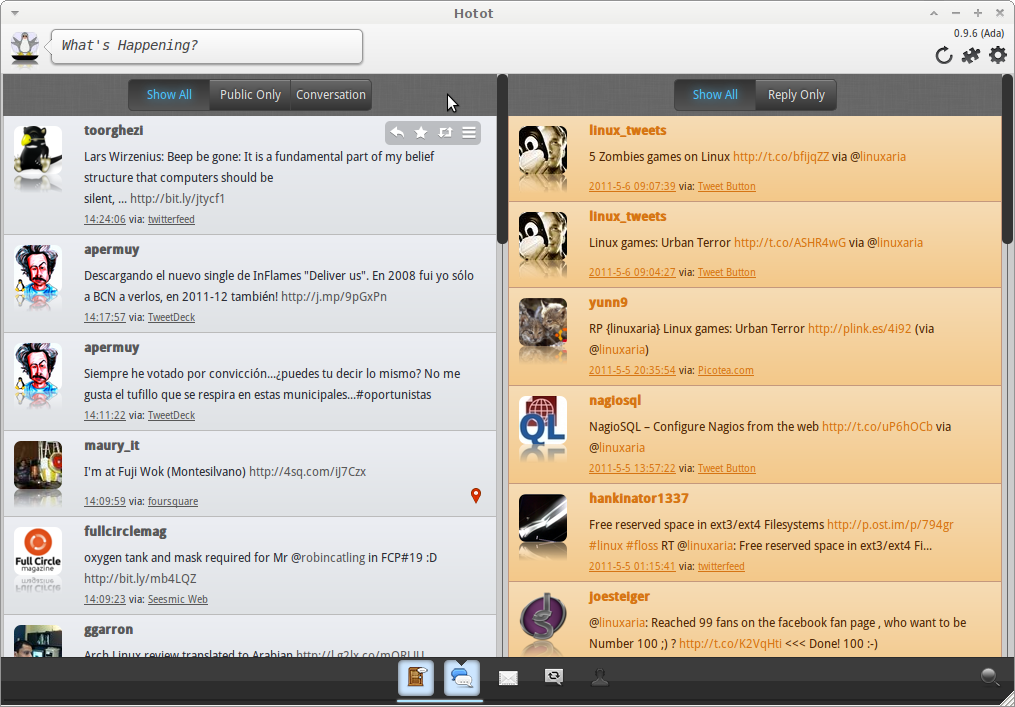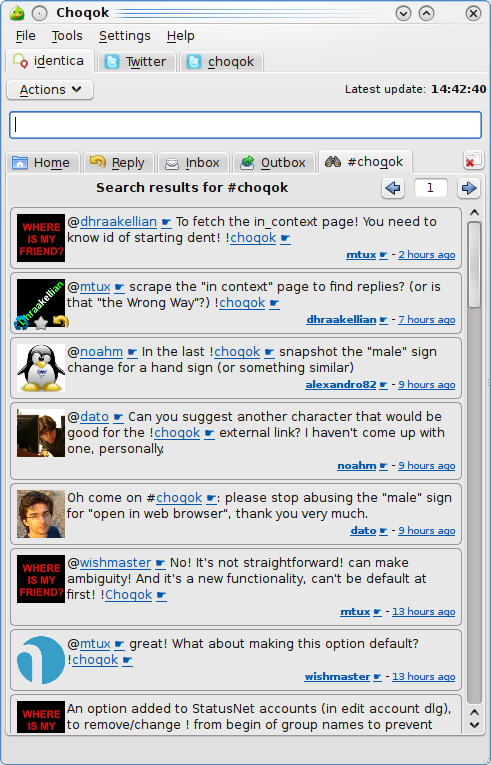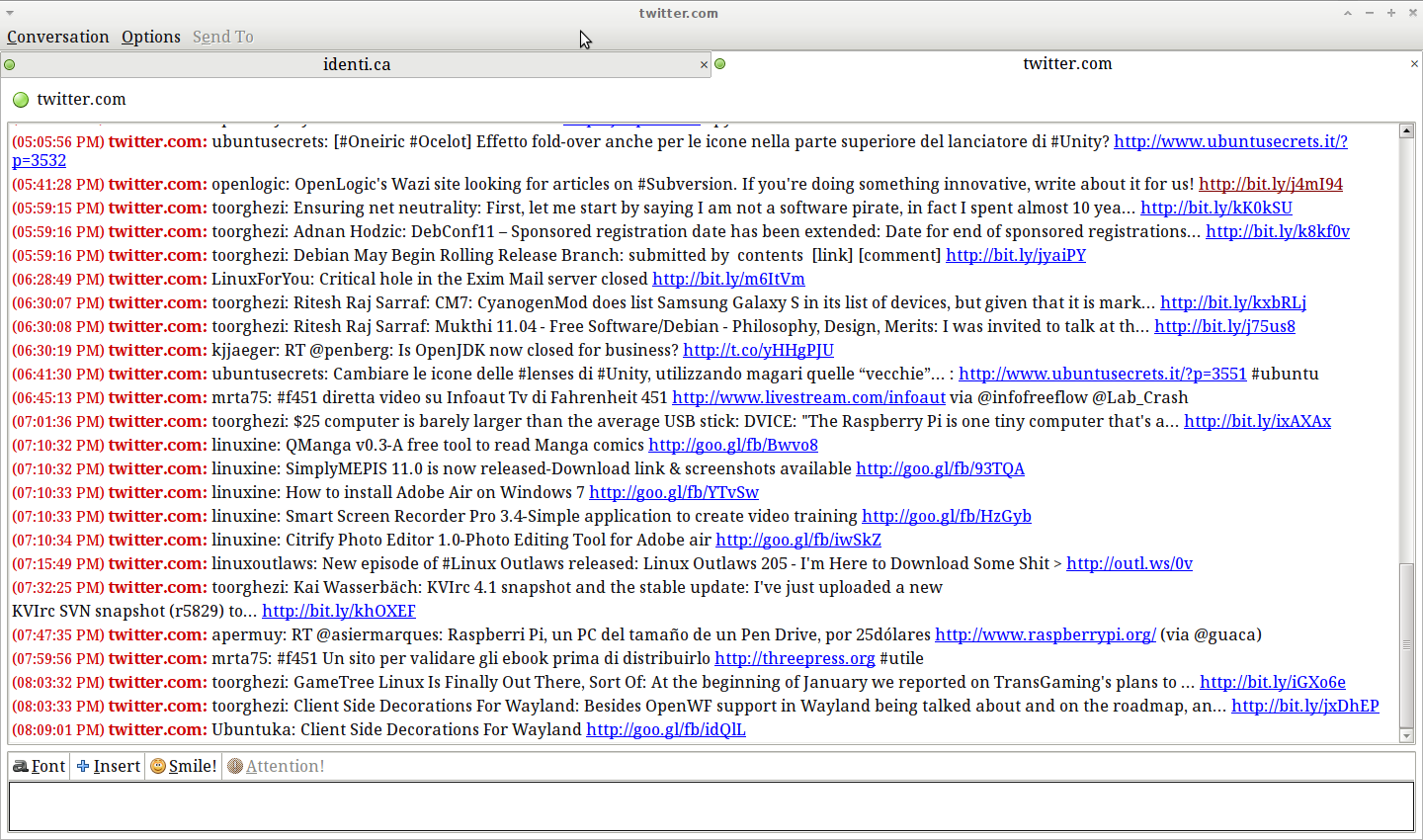 After the social networks the new trend on the Net it’s the microblogging, choose your style: Twitter, identi.ca, Picotea or something else but at the moment this is a must for the internet addicted, or just for keeping in touch with all the news you are interested in or just with your friends.
After the social networks the new trend on the Net it’s the microblogging, choose your style: Twitter, identi.ca, Picotea or something else but at the moment this is a must for the internet addicted, or just for keeping in touch with all the news you are interested in or just with your friends.
So, while it’s always possible to use your favorite browser to keep in touch with all these messages, today we’ll see some Micro-blogging clients on Linux.

Hotot
This is a Twitter and Identi.ca client, that is becoming popular due to his nice graphic and possibility to add extensions that do different things, among who the possibility to translate any message in a predefined language, or a configurable url shortener (at the moment you can choose among is.gd, TinyUrl, bit.ly, karmacracy or a custom url)
Depending on the size of your screen or how much do you extend it, you’ll see 1,2 or more panels the first it’s the timeline with all the messages of people that you follow and reply/direct messages to you, the second contains the Mentions to your messages, the third is an inbox/outbox for messages, forth is the Retweet and retweeted panel and the last one it’s a search for people. Being born for Twitter also in Identi.ca you’ll have the Twitter terms, but this is not a big issue.
Installation
Hotot is available for Ubuntu,Fedora, Mandriva, Arch and Gentoo more info here
For Ubuntu, just add the official PPA and install it:
sudo add-apt-repository ppa:hotot-team sudo apt-get update sudo apt-get install hotot |
Another great things of Hotot is that it’s also available as Chrome extension.
Conclusions
Great client, with nice graphic and a lot of functions and extensions, i’d love to make search and save them in custom panel, or the possibility to have both Identi.ca and Twitter side by side. For sure a mature micro-blogging client.
Gwibber
Gwibber is an open source microblogging client for GNOME developed with Python and GTK. It supports Twitter, Identi.ca, StatusNet, Facebook, Flickr, Digg, FriendFeed, and Qaiku.
I’ve tested release 3.0.0.1 available on Ubuntu 11.04 repository with plugins for Twitter,Identi.ca and Facebook, for other distributions check the official page on launchpad
The main window of Gwibber show all services differentiated by different colors depending on the service of origin, so you have in 1 stream all the incoming news, in another all the reply and so on.
It’s also possible to split vertically the windows and choose which stream show in each page.
When you send a message you can choose on which service publish it and URL shortening services are activated automatically when an URL it’s present in the message.
Conclusions
Gwibber “could” be the best micro-blogging client around, but there is something in his graphic that i don’t like, but i really like the possibility to have all my accounts of the various services in 1 window.

Choqok
Choqok ( pronounced: tʃœˈʁʊk ) is a Free/Open Source micro-blogging client for K Desktop Environment.
The name comes from an ancient Persian word, means Sparrow!
Currently supports Twitter.com, Identi.ca and opendesktop.org services.
I have not tested but I quote the great review done on UbuntuBond : Fast and lightweight, perhaps the best client for Twitter, which uses the QT4 libraries and integrates well in KDE4 environment.
Recently has been released the latest version, now available for Maverick and Natty, which incorporates a filter to the Timeline for easy reading tweets, and a plugin for the translation.
Installation:
It’s availbe as PPA on Ubuntu, open a terminal and type:
sudo add-apt-repository ppa:adilson/experimental sudo apt-get update sudo apt-get install choqok |
For other distributions check the download page
Once the installation is done you find the program in: Applications -> Internet -> Choqok.
Twidge
Twidge is a tool for interacting with microblogging sites such as Twitter and identi.ca.
Twidge is a full command-line client. It is designed to be useful when you’re sitting at a shell prompt. It’s also designed to work well with the Unix/POSIX/Linux shell scripting environment. It produces output in well-formed and easily-parsed ways, and has various features for working with piped data.
It can be used to:
- Simply update your own status and following your friends
- Setting status based on system events
- Receiving status updates via email, and sending your friends and your replies to email
- Scheduling status updates for the future
The package it’s available on the repository of Ubuntu 11.04, so to install it i just typed in my terminal:
aptitude install twidge |
The package it’s also available on the Debian 6 repository, as usual check the official page for other distro.
The first thing to do is set up your account, on the terminal type twidge setup and you’ll get the instructions:
#- twidge setup Welcome to twidge. We will now configure twidge for your use with Twitter (or a similar service). This will be quick and easy! Please wait a moment while I query the server... OK, next I need you to authorize Twidge to access your account. Please cut and paste this URL and open it in a web browser: https://api.twitter.com/oauth/authorize?oauth_token=nvvnjn12e7812canlUna8fgbhirFmvcap112 Click Allow when prompted. You will be given a numeric key in your browser window. Copy and paste it here. (NOTE: some non-Twitter services supply no key; just leave this blank if you don't get one.) Authorization key: 000000111 Successfully authenticated! Twidge has now been configured for you and is ready to use. |
The default setup configures your Twitter account, if you want to setup an identi.ca account you have to edit the file .twidgerc, before giving the command setup, in your home directory and put :
serverbase: http://identi.ca/api shortenurls: yes urlbase: %(serverbase)s
Now, let’s start exploring. twidge lsrecent -su will show you the 20 most recent updates from the people you follow. After the first time, it will remember what you’ve seen and only show you new updates.
In place of lsrecent, you could use lsreplies to replies to you.
In short, -s tells the system to save what you’ve seen, and -u tells it to only show you unseen items.
You can subscribe to updates from friends by running twidge follow nick. To subscribe to updates for Linuxaria , you’d run twidge follow linuxaria. If you’ve had enough of updates from someone, just use the twidge unfollow command.
Now, how about posting your own updates? Just type twidge update.
Type your update, and press Enter when done.
You may obtain a list of all commands with twidge lscommands.
Qataki
Qataki is a command line Identi.ca/StatusNet/Twitter client. It’s a shell script that, besides usual UNIX utilities (like sed/awk/grep), depends on curl and ELinks (or Lynx if ELinks is not installed).
- Identi.ca, Twitter and arbitrary StatusNet sites
- Post, reply, retweet, delete, favor, send direct messages
- Read personal, public, users and groups timeline (last statuses)
- Read messages directed to you (i.e., where you are mentioned)
- Multiple accounts support
- Read messages in context (conversations available only for Identi.ca/StatusNet sites)
- Type a message with your $EDITOR (this is optional and done with qataki U)
- Search for notices
- Pastebin.com and omploader.org integration
- Open URLs in a text-based web browser
- Optionally sort messages in chronological order (oldest first)
- Use a killfile to remove messages that contain certain strings
Installation
Just downlaod the following file: qataki, and run it, the first time will ask for your informations:
# bash qataki Create/modify account? [Y/n] y 1) Identi.ca 2) Twitter 3) StatusNet #? 1 Configuring Identi.ca Nickname: linuxaria Password: ************ Is linuxaria your default identi.ca account? [Y/n] y Done! |
Now the basic options that you can use with the command qataki are:
qataki [i|t|s:] [n:] [
The first (optional) flag can be: i (identi.ca) OR t (twitter)OR s: (see below). If none of these three flags are given,
then Identi.ca will be used. It is possible to use only 1 OPTION and, eventually, its ARGUMENT. If no option is passed, messages
from people you follow will be retrieved by default.
To see all the available options use qataki -h
Conclusions for the 2 command line clients
They are both really nice, from a test run of around 30 minutes for each of them it seem that qataki as more options and features but twidge it’s really simple to set up and use, so make your choice, but having a command line client open a lot of possibility, like schedule in cron some messages or a check that send you a message on Twitter/Identi.ca if something go wrong.
Pidgin
As last client i show you an option in Pidgin to see all your Twitter and Identi.ca messages, probably it’s not good like a dedicated micro-blogging client but if you already use Pidgin it could be a good thing to have all integrated there.
To have this you have to install the package pidgin-microblog that in Ubuntu is available on the repository.
Once installed in the “add account” menu of pidgin you’ll be able to choose also Twitter and Identi.ca with your username/password.
Once you sign in you’ll start to receive the news of these 2 sites like pidgin messages.
You can also use the following commands in the conversation window:
/replies – to get all replies to you
/refresh – get new tweets instantly
/tag, /btag, /untag – automatically tag all your message, good for tagging messages with some hash tag (Example: #ubuntu)
For more commands, type “/help”.
Conclusions
All the clients that i presented have some nice features, so it depend on what do you use usually or like more, command line, nice graphic, integration with an instant messaging system ? As usual on the GNU/Linux world the choice is your, and you cannot be wrong.
And don’t forget to follow me on Twitter and/or Identi.ca
Popular Posts:
- None Found



You forgot Pino.
… and the microblog-purple plugin for pigdin… 😉
Give a look to http://turpial.org.ve/
Thanks for the tips, the site only in Spanish don’t help, but the software seem really nice.
I’ll test it 😉
I’ve used some of the clients mentioned in this article, and some of the others I will try out. At the moment, my favorite twitter client is ttytter. It’ a command line client, but the best client I’ve used yet.
link: http://www.floodgap.com/software/ttytter/
One additional micro blogging client that I would highly recommend is identicurse. It is an identi.ca client (I’m not sure if it works with Twitter as I don’t use it) that runs from the command line. I’ve been using it now since January and I am incredibly happy with it. It is developed by @reality and @psquid on identi.ca, both of whom are very helpful and seem to be online 24 hours between them.
Nils: thanks for the link, I’m going to check out Turpial
Thanks for the info Kevie.
You can find information on Turpial also on Linuxaria
Nothing more is needed than a chat client to use for interacting with the Jabber bot. Bitlbee not only has Jabber support (and it’s an amazing client), it also has Twitter support, which means it can take advantage of Identi.ca (seeing as though they remain compatible with the Twitter API).
Thanks for the tips Aaron, anc congrats for your Blog, i’ve found some interesting topics there 😉
I genuinely treasure your work, Great post.